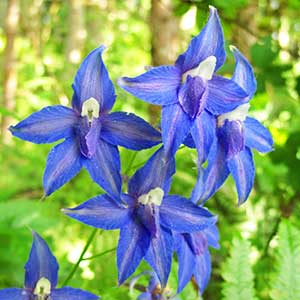Delphinium trolliifolium
Delphinium elatum
Columbian larkspur, cow-poison, poison delphinium, poison larkspur
candle larkspur, candle larkspur (vascan: harms 2006), larkspur
(40-)60-120(-180) cm;
base usually reddish, glabrous to puberulent.
40-200 cm;
base green, pubescent or glabrous.
blade ± pentagonal, 4-8 × 7-16 cm, margins ± incised, nearly glabrous; ultimate lobes 0-9, width 15-30 mm (basal), 5-20 mm (cauline), widest at middle or in proximal 1/2.
blade round to pentagonal, 3-15 × 6-22 cm, ± puberulent; ultimate lobes 3-9, width 8-30 mm.
(5-)14-40(-75)-flowered, ± open, at least 2 times longer than wide;
pedicel 1-4(-9) cm, puberulent to glabrous;
bracteoles (2-)6-12 mm from flowers, green, linear, 5-9(-14) mm, puberulent.
25-100(-more)-flowered;
pedicel 1-3(-5) cm, glabrous to pubescent;
bracteoles 2-5(-9) mm from flowers, green, linear, 5-9 mm, ± puberulent.
sepals dark blue, glabrous, lateral sepals spreading, (8-)14-21 × 5-9 mm, spurs straight or downcurved at apex, within 20° of horizontal, (10-)16-23 mm;
lower petal blades covering stamens, 5-10 mm, clefts 1.5-3 mm;
hairs sparse, mostly near junction of blade and claw, centered or on inner lobes, well dispersed, yellow.
sepals blue, white, or purple, ± puberulent, lateral sepals spreading, 12-23 × 4-12 mm, spurs straight, ascending ca. 45° above horizontal, 15-22 mm;
lower petal blades elevated, exposing stamens, 3-5 mm, clefts 0.2-1 mm;
hairs sparse or dense, mostly near center of blade, yellow or white.
(15-)23-34 mm, 3.8-5.5 times longer than wide, glabrous.
13-20 mm, 3.5-4.5 times longer than wide, ± puberulent.
unwinged;
seed coats smooth.
winged;
seed coats ± with small wavy ridges, cells elongate, surface roughened.
= 16.
Delphinium trolliifolium
Delphinium elatum
Delphinium trolliifolium occurs in the northern Coast Range of California, the Columbia River Valley to just east of Mt. Hood, and the Willamette Valley of Oregon upstream to Lane County. California plants differ somewhat from Oregon plants in pubescence patterns and habitat preferences. Further study may show that two entities are involved here.
Hybrids between Delphinium trolliifolium and D. decorum, D. menziesii subsp. pallidum (D. ×pavonaceum Ewan, Peacock larkspur), D. nudicaule, D. nuttallianum, and D. nuttallii are known. Delphinium trolliifolium is likely to be confused only with D. bakeri. Refer to discussion under that species for differences.
(Discussion copyrighted by Flora of North America; reprinted with permission.)
Delphinium elatum is cultivated as a garden plant or for cut flowers. It is not known to be naturalized extensively in North America; it may persist long after cultivation in cooler parts of the region.
(Discussion copyrighted by Flora of North America; reprinted with permission.)


